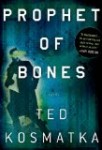What if?
To me, those two words are one of the keys to good science fiction. The writer looks at a current state of affairs in politics, society or science (or all three), asks “What if?” and their imagination creates the foundation for a story. It certainly seems like that’s the method Ted Kosmatka used with Prophet of Bones.
 What if carbon-dating established that life the Earth was 5,800 years old? What if evolution is not only in the the scientific junk heap but considered fringe pseudoscience? What if intelligent design is the gold standard for the history of life on Earth?
What if carbon-dating established that life the Earth was 5,800 years old? What if evolution is not only in the the scientific junk heap but considered fringe pseudoscience? What if intelligent design is the gold standard for the history of life on Earth?
Those are among the questions contributing to what Kosmatka calls “lab-opera,” works involving scientists in trouble. Although Prophet of Bones takes the protagonist, Paul Carlsson, to an archaeological dig on an Indonesian island, much of the plot development occurs after he leaves the island and returns to his laboratory job analyzing fossils. Lab-opera, though, might be a bit too narrow. The book actually has elements of both hard sci-fi and soft sci-fi and easily can be slotted into the techno-thriller genre. The combination may not be surprising given that Kosmatka works as a writer for company that has made highly popular game software.
Prophet of Bones is hard sci-fi in the sense that Kosmatka not only explores the science of genetics but discusses various principles in the field. Given the terminology of modern genetics, he might have explained some of the terms a bit more for science-impaired readers like me. Of course, understanding the science isn’t necessarily essential to the key sci-fi and techno-thriller readers.
The book is soft sci-fi to the extent that an underlying theme is the potential societal impact of DNA Carlsson extracted from fossils found on the dig. What kind of society would arise exist It is clear that the DNA is perceived as a potential threat to the scientific canon, leading to its theft and resolute efforts to keep it from Carlsson and others. Personally, I would have preferred a bit more on the ramifications of what Carlsson suspects but that could be another book in and of itself.
The techno-thriller aspect is almost a no-brainer. We have murky antagonists with inordinate interest in getting their hands on the DNA for some mysterious scheme. They take extreme measures to get the DNA and keep Carlsson from investigating it. Of course, these efforts put Carlsson in several life-threatening situations. Against all odds, the mild-mannered lab rat escapes death, often by physical confrontation with his adversaries. While this requires perhaps more suspension of belief than the balance of the tale, we all know the hero isn’t going to die — or if he does, it will only be once the answers are revealed.
There are also two characters who loom over the book, one more meaningful than the other. The book begins with the Prophet, although he seems more to be a mechanism of sorts and doesn’t’ really reappear in the tale. More often invoked is Carlsson’s deceased father. A brilliant scientist, he had an explosive temper and no qualms about beating his wife. We suspect he has some relationship to a broad conspiracy but the denouement seems a bit too contrived, perhaps because his professional life and pursuits are left underdeveloped.
All in all, though, Prophet of Bones is a workmanlike blend of the various genres it invokes. It certainly is an engaging introduction to and explication of “lab-opera.”
Most people who are depressed are depressed because their lives suck.
Ted Kosmatka, Prophet of Bones.







